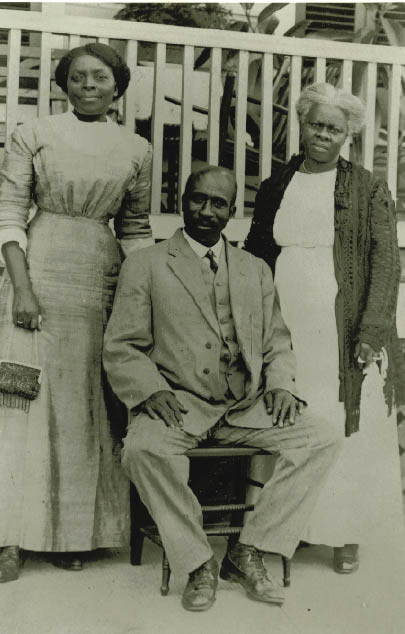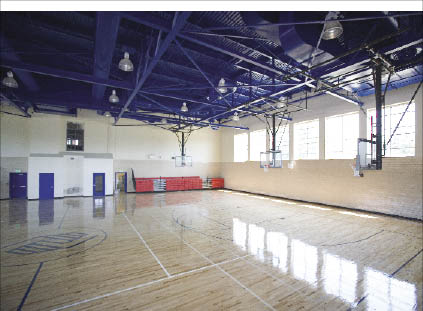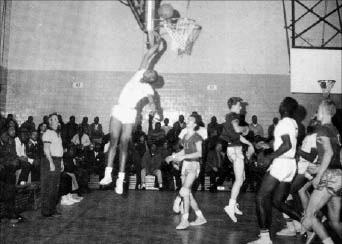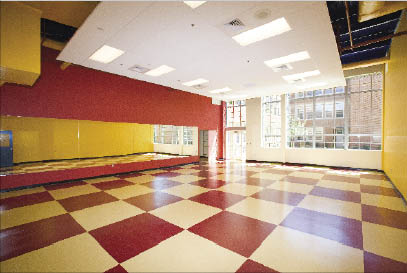A Dream No Longer Deferred
The Wiley H. Bates Heritage Park Opens
By Nancy Breslau Lewis

When the grand opening of the Wiley H. Bates Heritage Park on Smithville Street gets underway on September 8th, the spirit of Wiley Bates-Annapolis's early 20th-century African-American philanthropist, alderman, real estate entrepreneur and general go-to guy-will be hovering over every aspect of the festivities. For Bates' long-time interest in promoting educational and cultural opportunities for the city's underserved black youth, and his wish (as put forth in his will) to establish "The Bates Old Peoples Home" is wonderfully reflected in the mix of activities that will keep the Heritage Park complex humming seven days a week.
The revitalization and expansion of the former Wiley H. Bates High School, after being invaded by rainwater, birds and graffiti artists for 25 years, is nothing short of remarkable. The new 124,000 square-foot complex, built at a cost of nearly $27 million, incorporates most of the original 1933 high school structure. It will house 71 one-bedroom rentals units for low-income seniors; a full-service Senior Center; a Boys & Girls Club facility with classrooms and a renovated, full-size gym; community ball fields; and the Wiley H. Bates Memorial Courtyard and Legacy Center.

The story of how this sunny facility, with its sleek interior walls painted in bright mandarin red and gold hues, turned from a dream into reality, involved decades of politicking, alumni and neighborhood activism, searches for funding and-most importantly-a growing awareness that the Bates High School building was a true cultural landmark in Anne Arundel County. During a period when schools were rigidly segregated, and local black students had no high school of their own to attend, the laying of the cornerstone of Wiley H. Bates Colored High School in 1931-made possible by Bates' donation of $500 towards the purchase of the land on which the school stood-signified a turning point in the lives of Annapolis' black citizens.
The building itself was impressive-a rarity in an era when "separate" rarely meant "equal." During the 1930s the county school calendar was 40 days shorter for black students than for their white counterparts, and black teachers had to lobby-and sometimes sue-the county for equal pay and teaching materials. Substantial wings were added in the 1940s and in 1950, and during its heyday, Bates High School offered a full range of academic and vocational courses to as many as 2,000 students each year.

Ironically, it was the mandatory desegregation of the county school system in 1966 that caused Bates' luster to dim. In the reshuffling of students that followed, to reduce de facto segregation, Bates students and teachers scattered and the facility-renamed "Annapolis Middle School"-served only ninth and tenth graders. Two years later, the school was reconfigured as the "Wiley H. Bates Junior High," and by 1981 the building had deteriorated so badly that it was abandoned and eventually became the property of the county.
The revitalization and expansion of the former Wiley H. Bates High School, after being invaded by rainwater, birds and
graffiti artists for 25 years, is nothing short of remarkable. The new 124,000 square-foot complex, built at a cost of nearly $27 million,
incorporates most of the original 1933 high school structure.
Even as the building continued to decay, neighbors, civic activists and loyal alums began stirring up interest in saving the site. As Kathleen Koch, Executive Director of Arundel Community Development Services, Inc. (ACDS), the county's non-profit housing and community development agency, points out: "People remain so tied to this school-there's unbelievable school spirit. They remember exactly where their lockers were located and all the words to their school song." Koch recalls that in the early 1990s "a proposal to renovate the building as a community center, to be funded by the construction and sale of townhouses on the back ball fields, went down in flames before the city council." But that sparked the formation of an advisory committee composed of governmental representatives and community leaders, who by 1994 had pinpointed the five principle uses of the site that were eventually implemented. That same year, in recognition of its historic and cultural significance, the Wiley H. Bates High School site was placed on the National Register of Historic Places.
 Koch notes that "The project had many complications, including the fact that all three levels of government had a say in the ultimate reuse of the property. The County owned the property, the City controlled the zoning and the State had final approval of the reuse due to outstanding bond issues on the project. The County hired ACDS in 1995 to facilitate and manage the redevelopment of the site." Koch notes that "The project had many complications, including the fact that all three levels of government had a say in the ultimate reuse of the property. The County owned the property, the City controlled the zoning and the State had final approval of the reuse due to outstanding bond issues on the project. The County hired ACDS in 1995 to facilitate and manage the redevelopment of the site."
"The first task we needed to do was to determine the condition of the building," Koch recalls. "We then began to bring together the users of the building and the financing. We prepared preliminary designs-laying out how different areas of the building would be used-and put together 12 sources of financing. We held two charettes (meetings in which members of the community join in the design process), chose the housing developer, brought in the Boys & Girls Club, hired architectural teams and managed the construction process."
By the fall of 1999 a new roof was installed to stabilize the structure, and lead and asbestos were abated. Funding was cobbled together from a variety of public and private sources, and in 2002 proposals from developers concerning the housing portion of the project were rigorously reviewed by representatives from all levels of government and the community. Eventually Community Preservation and Development Corp. and Northern Real Estate, Inc. were chosen to lead the development. Alt Breeding Schwartz Architects designed the Senior Center and Boys & Girls Club facilities, which were constructed by Tech Contracting, Inc. The Edgecombe Group directed the design for the Memorial Courtyard, Michael Dowling designed the Legacy Center, and Drum, Loyka & Associates were responsible for the refurbishment of the ball fields and other off-site improvements.
 Wiley Bates himself would be tickled with the phoenix-like transformation of the school that bears his name. The cheerful rental units, located in the old classroom wings of the building, include all the amenities that foster independent living-including high speed internet access in each apartment and a beauty shop down the hall. There's even access to a health suite in the adjacent Senior Center, offering mini-massages and medical screenings, including flu shots, blood pressure and blood sugar checks. Hallways linking the apartments showcase memorabilia from the former high school and retain the original tile floor so familiar to generations of Bates students. Wiley Bates himself would be tickled with the phoenix-like transformation of the school that bears his name. The cheerful rental units, located in the old classroom wings of the building, include all the amenities that foster independent living-including high speed internet access in each apartment and a beauty shop down the hall. There's even access to a health suite in the adjacent Senior Center, offering mini-massages and medical screenings, including flu shots, blood pressure and blood sugar checks. Hallways linking the apartments showcase memorabilia from the former high school and retain the original tile floor so familiar to generations of Bates students.
The entrance to the Senior Center is found at the back of the building, facing the ball fields. Managed by the Anne Arundel Department of Aging and Disabilities, the 22,500 square-foot facility (located in the former school's shop wing) has impressive bells and whistles. Seniors entering the center can check in at a station with a computerized touch pad and proceed to select from a wide variety of activities. There's a light-filled dance studio, a billiards room, art classrooms supplied with kilns, a card room, and a parlor for schmoozing. There are three computer stations reserved for public use and a classroom outfitted with a bank of 16 Dell computers for those interested in honing computer skills. Hot lunches will be served in the dining room and snacks will be available at a snack bar; but not to worry, a dance floor gracing a large multipurpose room and a well-equipped exercise room will provide plenty of opportunity to burn off extra calories.
 Business promises to be brisk at the Annapolis Senior Activity Center. Director Becky Batta anticipates that between 100 and 300 seniors will visit the facility each day. Although one-third of the attendees will arrive via van pools, according to Batta, parking will be generous by Annapolis standards, with 283 available spaces and more handicap spaces than code requires. Pedestrians should find the going easier, too, once the sidewalk on Smithville Street is extended all the way to Spa Road. Business promises to be brisk at the Annapolis Senior Activity Center. Director Becky Batta anticipates that between 100 and 300 seniors will visit the facility each day. Although one-third of the attendees will arrive via van pools, according to Batta, parking will be generous by Annapolis standards, with 283 available spaces and more handicap spaces than code requires. Pedestrians should find the going easier, too, once the sidewalk on Smithville Street is extended all the way to Spa Road.
The third jewel in the crown of the Bates Heritage Park is the Boys & Girls Club, which will serve more than 4,000 youths annually at the new site. Years ago the Boys & Girls Club launched a $3 million capital campaign soliciting public support for their new facility, and received over $500,000 from the County and a 50-year lease for $1 per year, as well as $750,000 from the State of Maryland and $80,000 from the City of Annapolis. The 22,800 square-foot club features a renovated, full-size gym, a teen center and classrooms that have been carved out of the former high school cafeteria.
Every day of the week there will be a lively mix of classes, crafts, basketball clinics and games at the Boys & Girls Club, and on the ball fields located behind the complex will be managed by the Annapolis Department of Parks and Recreation. Planning is underway to find ways to facilitate intergenerational activities between the youths and seniors who will be congregating at the Heritage Park.
The fifth design element in the complex is the Wiley H. Bates Memorial Courtyard and Legacy Center, located in the school's original courtyard and library. Some of the design concepts incorporated in the memorial were generated during the community charettes held in late 2002. The space will have the look and feel of a 1950s schoolyard, and will feature the school's original flagpole, the school emblem, a statue of Wiley Bates and limestone plaques detailing the story of the building and its significance in Annapolis history. Rotating exhibits will explore the history of the school and its students and teachers, as well as the life and times of Wiley Bates and the community he strove to serve.
 And that's a story straight from the pages of Horatio Alger. Born in 1859 in Wadesboro, North Carolina, Wiley Bates early on learned the value of personal responsibility. By the time he was nine years old, he hired himself out to work on the Chesapeake and Ohio Railroad to bring in money to help support his family. When his father died a few years later, Bates' mother Harriet-who had been born and raised in St. Margaret's, Maryland-took her son back north to settle in Annapolis. During his teen years he culled oysters on the Chesapeake Bay each fall, winter and spring season. Summers found him waiting tables at the Grand Hygeia Hotel at Old Point Comfort, VA, and at the Bryn Mawr Resort in PA, where he was thrilled to meet such luminaries as Generals Grant and Sherman. And that's a story straight from the pages of Horatio Alger. Born in 1859 in Wadesboro, North Carolina, Wiley Bates early on learned the value of personal responsibility. By the time he was nine years old, he hired himself out to work on the Chesapeake and Ohio Railroad to bring in money to help support his family. When his father died a few years later, Bates' mother Harriet-who had been born and raised in St. Margaret's, Maryland-took her son back north to settle in Annapolis. During his teen years he culled oysters on the Chesapeake Bay each fall, winter and spring season. Summers found him waiting tables at the Grand Hygeia Hotel at Old Point Comfort, VA, and at the Bryn Mawr Resort in PA, where he was thrilled to meet such luminaries as Generals Grant and Sherman.
Apparently this exposure to the sparkling conversations in those dining rooms inspired him to seek opportunities to expose himself to a broader world. With only a couple of days of formal schooling under his belt, Wiley Bates set out not only to dress elegantly, but to make a name for himself. He became active in Annapolis's Asbury Methodist Episcopal Church, where he organized a debating society. By 1880 he had started a small business selling crabs and oysters, and soon realized it was even more lucrative to sell cord wood and other staples. He ran his profitable grocery store, located on Cathedral Street, for 33 years.
Bates became a Republican alderman for Annapolis's third ward in 1897. He worked hard for his largely black constituents, and in 1899 erected a room at the rear of his home to serve as Annapolis' first kindergarten. When he retired from the grocery business to focus exclusively on his real estate portfolio and community activities, 26 real property transactions had been recorded in his name. Bates was a member of a number of fraternal organizations, and served as a trustee of Wilberforce University in OH and of Annapolis's Stanton School. His support of the first black high school in Annapolis underscored his lifelong commitment to achievement and giving help to his neighbors. As he wrote in his memoirs, published in 1928 as The Researches, Sayings and Life of Wiley H. Bates, "It is not with egotism that I boast on some of my accomplishments but it is to educate others what can be attained with pluck and perseverance."
This passage could well have served as his epitaph. Wiley H. Bates, Annapolitan extraordinaire, died of a cerebral hemorrhage in 1935 and is buried in Brewer Hill Cemetery.
Some of the design concepts incorporated in the memorial were generated during the community charettes held in late 2002. The space will have the look and feel of a 1950s schoolyard, and will feature the school's original flagpole, the school emblem, a statue of Wiley Bates and limestone plaques detailing the story of the building and its significance in Annapolis history.
Back
|

